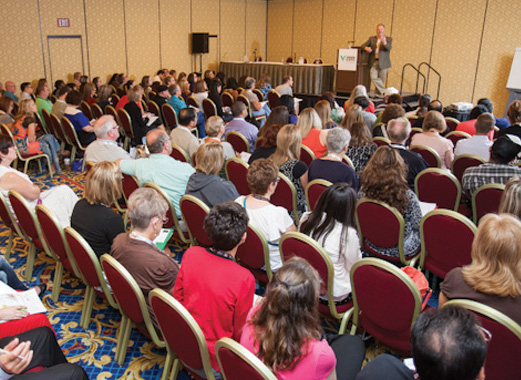 |
|
| A full crowd at last month's Vision Expo West.
|
Don’t Hold Back
“Many of our programs sold out, including our exclusive 14-hour glaucoma program,” Dr. Smick says of the four-day-event, held last month in Las Vegas. “The whole concept behind the glaucoma track was that many optometrists are diagnosing glaucoma and then referring. These courses were created to help optometrists intervene in treatment. Many optometrists are still holding back.”The glaucoma track included such courses as “Optic Nerve and Imaging,” presented by optometrist Ben Gaddie. “The optic nerve examination is still the first clinical test that will alert you to glaucomatous damage, not the OCT or visual field,” Dr. Gaddie says. “One of the biggest reasons clinicians miss optic nerve findings related to early glaucoma is because of looking at the cup rather than the neuroretinal rim. A systematic approach to optic nerve examination—aided by OCT retinal nerve fiber layer and ganglion cell layer analyses, as well as a careful review of OCT optic nerve parameters—gives the highest sensitivity.”
Other Hot Topics
Other clinical highlights from VEW: a new nutraceutical track with courses that covered macular degeneration and nutritional supplements that impact both the front and back of the eye.“With AREDS2 just out, there has been a lot of confusion and a lot of questions about what supplements should be given to patients,” Dr. Smick says.
To that end, two leaders in nutraceuticals, Stuart Richer, OD, PhD, and Jeff Anshel, OD, presented the “Nutrition in Eyecare Symposium,” educating attendees on how Americans are self-prescribing and spending more than $20 billion annually on herbal and dietary supplements, and also that eye care providers need to receive timely, evidence-based information to address the risks and benefits of supplements to their patients. The duo provided an overview of the issues related to nutritional influences on visual health, including details of the recently released data of AREDS2 study.Another first at VEW was a new lens specialist program, designed for both opticians and optometrists.
“We realize there are so many spectacle lens options now and so many new designs, and it’s hard for opticians and optometrists to keep up. Now more and more optometrists are getting involved in prescribing lenses,” Dr. Smick says.
One popular course in the spectacle lens specialist track was “How Important Are the Measurements You Take?” presented by Laurie Pierce, LDO, ABOM, NCLC, who provided the whys and hows of advanced optical measurements and their importance to provide the best visual experience possible for patients.
VEW also shone a spotlight on the latest advances in eye care. Dr. Smick co-presented “What’s New in Optometry,” where he shared three new technologies that are changing the way optometrists practice, including new cheek swab genetic testing for AMD (Macula Risk PGx, ArcticDx), a dry eye test that generates an osmolarity number based on a patient’s tear sample (TearLab, TearLab Corp.), and a diagnostic test that aids in the rapid differential diagnosis of acute conjunctivitis (AdenoPlus, Nicox).
Mark your calendar for the next Vision Expo West, to be held at the Las Vegas Sands Expo & Convention Center, September 17 to 20, 2014.

